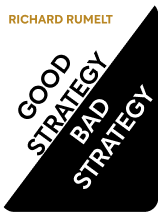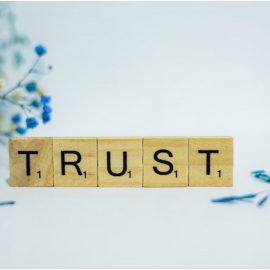

This article is an excerpt from the Shortform book guide to "Good Strategy Bad Strategy" by Richard Rumelt. Shortform has the world's best summaries and analyses of books you should be reading.
Like this article? Sign up for a free trial here .
Do you want to take your business to the next level? What are the main weaknesses your organization is facing?
When running your business, you must not only focus on your strengths, but you must also be aware of your weaknesses. These weaknesses might be a weak link in your operations (a department that’s not functioning properly or a product that’s bleeding profits) or it may be the development of organizational inertia or entropy (stasis or disorganization).
In this article, we’ll discuss common organizational weaknesses—inertia and entropy, and how to prevent them from compromising your business at its core.
Analyzing Your Organization’s Weaknesses
When planning your organization’s strategy, focus not only on your opponent’s weakness but also on your own. Think of your organization as a chain; the chain as a whole isn’t strong if it has an internal weakness—a weak link—that might one day break it. Examine your organization for such a weakness, and once you’ve identified it, focus on strengthening that.
If you don’t address your organizational weaknesses, not only will you leave yourself vulnerable to future failure, but additionally, focusing resources on already-strong areas may actually make your organization weaker. Strengthening already strong links while neglecting weak ones will divert resources from where they’re needed most to an area that will not ultimately earn you a high return on investment: Adding strength to existing strength will bring about a smaller gain than adding strength to weakness. If you pursue this course of action, not only will your company become less efficient, but you will also incur opportunity costs: lost time or lost customers who were put off by the continued problems that you didn’t address.
Sometimes, a leader is faced with multiple points of weakness. In this situation, focus first on the areas that must be addressed in order to fix the other areas. This may sound obvious, but often, leaders try to fix all problems simultaneously and then run into trouble. For example, increasing your sales force will not turn around your company if you don’t first fix the underperforming equipment you’re selling.
For example, between 1980 and 2008, General Motors (GM) invested much time and money into improving the quality of their already-well-built transmissions, but didn’t address problems like faulty dashboard knobs and rattling door panels. Improving the transmission did little to entice customers who cared about shoddy quality elsewhere to buy GM cars.
Conversely, a well-managed chain can give you an insurmountable competitive advantage. When a company operates through a chain in which each link is strong and each is fully integrated with the other links, that company can dominate its market because of the simple fact that it is difficult for competitors to replicate such highly efficient chains.
Consider IKEA, the Swedish store that designs and sells ready-to-assemble furniture. Its success lies in its many coordinated policies: Its catalogues replace a sales force, its disassembled products reduce its warehouse and shipping needs, its customers help themselves to its products and thereby simplify its distribution, and because it designs its own products, it can better manage its logistics. These policies are well-known, but replicating one element without the others—one link without the rest of the chain—can’t propel a competitor to the same kind of success as IKEA.
A leader’s insight, and her choices of where to focus her resources, can be the difference between a poorly-managed chain (like GM’s during those decades) or a well-managed chain (like IKEA’s).
Watch for Inertia and Entropy
We’ll now look at two aspects of a company—inertia and entropy—that in large part determine whether or not it can adapt to change and whether or not it can stay sharp during periods of little change, setting itself up for success or failure when changes inevitably arise.
Inertia describes an organization’s resistance to change: its tendency to continue operating as it has in the past, and the difficulty it has implementing changes. Entropy describes the way an organization tends to devolve into a state of chaos—disorganized and with a lack of focus—if it is not actively managed, even in times of stability.
Inertia and entropy can pose great threats to an organization but also great opportunities. Sometimes, an organization’s biggest challenges are its own inertia (internal stasis) and entropy (inefficiency). However, an organization that takes advantage of other organizations’ inertia and entropy can leapfrog their success. Understanding these influences can help you craft strategy that might prevent their potential negative effects and might also exploit their potential.
Inertia Stops You From Making Needed Changes
If your organization suffers from inertia, it is less able to adapt to competitive changes. Inertia generally falls into one of three categories:
- Inertia of habits
- Cultural inertia
- Indirect inertia
Recognizing which category fits your own particular inertia can help you properly address it. Recognizing which fits a competitor’s inertia can help you exploit it.
Inertia of Habits
Inertia of habits and policies can prevent a company from quickly reacting to competitive threats.
Any sizable organization that’s been around for at least a few years relies on a set of routines and habits to guide its everyday operations, such as how it buys and markets products, pursues new business, hires talent, designs facilities, and outlines plans. This can benefit a company greatly; an organization does not have the time or resources to reinvent the wheel at every decision, and its ability to operate successfully is supported by layers of accumulated knowledge and expertise. However, these habits can be detrimental to a company when they preserve old ways of doing things that may not be appropriate when changes come along—for example, continuing to charge certain surcharges when your competitors have dropped the practice.
To change inertia that’s linked to habits and routines, a company needs to get its top management on board with the new way of thinking. Sometimes, top management sees the value in the changes and the company can be turned around quickly. Other times, managers who cannot adjust will need to be replaced, often with people from other firms who already use the new methods.
Cultural Inertia
Inertia of culture can also stop a company from reacting quickly to competitive challenges. “Culture” describes the stable, change-resistant elements of social behavior. Cultural inertia often shows up in overly complex processes and routines that a company has incorporated into its daily operations, such as managers who make virtually all decisions by committee, setting up endless meetings instead of delegating decision-making power to individuals.
Organizational culture can prove very hard to change. When presented with strategy solutions that deviate significantly from previous modes of thinking, executives often respond defensively, preferring to double down on existing beliefs and attitudes that drive the company, even if those norms are ultimately harmful.
For example, in the 1980s, AT&T knew it needed to enter the computer communications arena. As the owner of Bell Labs—developers of Unix, the operating system that today underpins Linux and Apple’s Mac OS X—the company seemed to have the resources needed to become a key player. However, its executives assumed that all problems would have complex solutions, a false belief that stemmed from their experiences running the company up to that point. Thus, when tasked with creating a computer network, AT&T ignored simple solutions presented to them and instead opted for a long, expensive, complex solution from Bell Labs. Because they were unable to see past their traditional beliefs in complexity, more nimble competitors were able to leapfrog them.
To break cultural inertia, a company must simplify the complex processes and routines that their workforce has become accustomed to. Such complexity usually hides waste and inefficiency. This means reducing administrative overhead, closing down or outsourcing non-essential operations, and culling unnecessary initiatives. Sometimes, an organization will need to fragment its departments to cut off harmful modes of thinking that cross operating units. Additionally, top management may need to be replaced in order to establish a new set of values and norms from the top down.
Indirect Inertia
At times, inertia comes from a company’s customers instead of from the company itself. If a company’s customers have not yet changed their buying habits in response to an industry change, the company might resist changing because it doesn’t want to let go of those sales that they’ve come to rely on. This kind of indirect inertia has the same result as when a company has inertia internally, because it prevents a company from adjusting to the changing landscape. A company suffering from indirect inertia is vulnerable to competitors because its rivals sense that they can make a play for the company’s business without the company responding.
An example of this was the Philadelphia Savings Fund Society (PSFS), a bank that continued to offer savings accounts with five-percent interest returns even when, in 1980, the prime interest rate set by the government hit 20 percent and other banks started to offer savings accounts with much higher rates as a result. PSFS chose not to follow its competitors’ leads because it reasoned that its average depositor was retired, unsophisticated, and unaware of the higher rates offered by other banks, and therefore the bank could get away with keeping interest rates low simply because their customers had inertia. This left it open to competitors, who could easily poach its customers without the bank mounting a meaningful response.
Indirect inertia can be resolved when an organization finally decides to endure short-term loss for long-term gain. If this happens quickly enough, a company might be able to recapture some of the opportunities it had passed up. If it delays making this change for too long, though, it may allow a competitor to establish dominance in the new landscape and may not be able to win back the new business.
Entropy Sets You Up for Failure
An organization suffers from entropy when it loses its edge, often because of a lack of ongoing competition that allows it to grow complacent. A properly functioning company uses conscious design to impose order on a chaotic set of business inputs. Without purposeful attention and active maintenance, this design starts to fall apart, and organizational coherence is lost. If your organization suffers from entropy, it is less able to prepare for competitive changes because its leadership is essentially asleep at the wheel.
You can see entropy when a company produces a wide, unfocused range of products, when prices are set low to please the salesforce instead of because it’s the best competitive strategy, and when executive bonuses outpace the value of the company.
Case Study: General Motors
General Motors (GM) provides an excellent example of organizational entropy and how it can impact a company’s sales. In the company’s early days of the 1920s, its leadership streamlined and focused its product line, reducing its offerings from seven makes that sometimes competed with each other to five clearly distinctive makes each positioned in a defined price range, so that, for example, a Chevrolet model didn’t overlap with a Buick model. This clear strategy propelled the company to great success through the middle of the twentieth century.
Unfortunately, after enjoying industry dominance for several decades, the company grew complacent and in the latter half of the century, its well-crafted strategy design loosened up. The different lines, operating within a decentralized structure, started following opportunities that benefited themselves individually at the expense of other divisions. For example, executives at Chevrolet noticed they could increase their own sales with a more expensive model, ignoring the fact that it would cut into Pontiac’s market share. Likewise, Pontiac noticed it could increase its sales with a more affordable model, ignoring the fact that it would eat into Chevrolet’s customer base.
As the company devolved into a loose, uncoordinated collection of unrelated divisions which ate into each others’ businesses, rather than an integrated, coherent whole that was focused on positioning itself in the wider marketplace, its sales declined. Oldsmobile was closed down in 2001 and GM declared bankruptcy in 2009. It then dropped its Saturn, Pontiac, and Hummer brands. Decades of unfocused management decisions had created a company without a clear vision on how to stay competitive.

———End of Preview———
Like what you just read? Read the rest of the world's best book summary and analysis of Richard Rumelt's "Good Strategy Bad Strategy" at Shortform .
Here's what you'll find in our full Good Strategy Bad Strategy summary :
- The essential components of good strategy and the faulty thinking behind bad strategy
- Specific and measurable techniques for designing a focused strategy for success
- How to overcome challenges and gain a competitive edge






